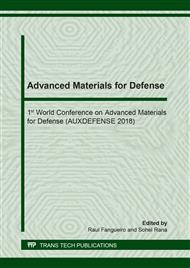[1]
Abdallah E.A. et al., Experimental analysis of damage creation and permanent indentation of highly oriented plates, Composites Science and Technology, 69 (2009) 1238-1245.
DOI: 10.1016/j.compscitech.2009.02.029
Google Scholar
[2]
Abrate S., Modelling of impacts on composite structures, Composite Structures, 51 (2001) 129-138.
DOI: 10.1016/s0263-8223(00)00138-0
Google Scholar
[3]
Abrate S., Castaiè B., Rajapakse Y.D.S., Eds, Dynamic failure of composite and sandwich structures, Solid Mechanics and Applications series n° 192, Springer, New York, (2013).
Google Scholar
[4]
Aboudi J., Arnold S.M., Bednarcyk B.A., Micromechanics of composite materials, Butterworth- Heinemann, Oxford, (2013).
Google Scholar
[5]
Aeronautica Militare Centro Sperimentale Volo-Reparto Chimico, Scansione ultrasonora di pannelli sottoposti ad impatto e successiva riparazione: Velivolo Typhoon, Report interno 2015. (in Italian).
Google Scholar
[6]
Aeronautica Militare Centro Sperimentale Volo-Reparto Chimico, Determinazione del lay-up del composito in fibra di carbonio e resina epossidica del velivolo EFA. Report interno 2015. (in Italian).
Google Scholar
[7]
Alenia-Aermacchi, Prove di impatto e successive riparazioni su provini upper-skin EFA in CFC. Report interno, 2015.(in Italian).
Google Scholar
[8]
Anderson T., Madenci E., Experimental investigation of low velocity impact characteristic of sandwich composites, Composite Strcutures, 50 (2000) 239-247.
DOI: 10.1016/s0263-8223(00)00098-2
Google Scholar
[9]
Silling S., Lehouco R.B., Peridynamic theory of solid mechanics, Sandia National Laboratories, Albuquerque, New Mexico, (2010).
Google Scholar
[10]
Silling S., Introdution to Peridynamics, Workshop on Peridynamics, Dissipative Particle Dynamics, and the Mori-Zwanzig Formulation, Brown University, April 10, (2012).
Google Scholar
[11]
Silling S.A., Askary E., A meshfree method based on the peridynamic model of solid mechanics, Elsevier, 83 (2005) 1526-1535.
DOI: 10.1016/j.compstruc.2004.11.026
Google Scholar
[12]
Silling S.A., Askari E., Peridynamic modeling of impact damage, ASME, (2004).
Google Scholar
[13]
Silling S.A., Bobaru F., Peridynamic modeling of membranes and fibers, International Journal of Non-Linear Mechanics, 40, 2, (2005) 395-409.
DOI: 10.1016/j.ijnonlinmec.2004.08.004
Google Scholar
[14]
Silling S.A., Dynamic fracture modeling with a mesh-free peridynamic code, Computational fluid and solid mechanics, 641-644, (2003).
DOI: 10.1016/b978-008044046-0.50157-3
Google Scholar


